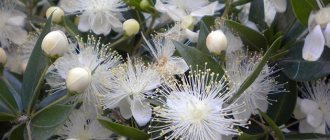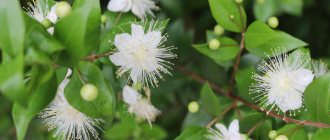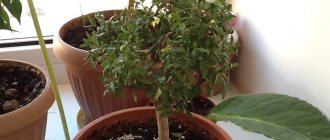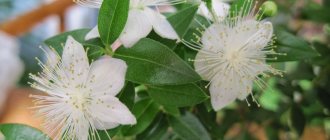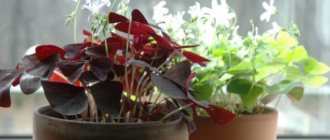Most people associate the myrtle plant with ancient Greek legends and the hot southern sun.
Indeed, the name of this shrub is of Greek origin and means “incense.” According to Greek myths, this tree is the embodiment of a nymph named Myrsina. The goddess Aphrodite herself wore a wreath of myrtle branches. Nowadays, some varieties of this evergreen plant are grown in pots. These are small-leaved myrtle (Myrtus microphylla) and common myrtle (Myrtus communis). There are many species found in nature. Biologists count more than a hundred varieties of this tropical crop.
Beneficial properties and harm of myrtle
Myrtus is a medicinal plant whose beneficial properties are used in medicine.
- Essential oils exuded from the leaves are natural phytoncides that disinfect the surrounding air.
- An astringent and bactericidal effect helps relieve inflammation and heal wounds.
- Increases body tone, improves immunity.
- Helps with skin diseases: dermatitis, psoriasis; cosmetology.
- Stimulates the nervous system.
In addition to its beneficial properties, the flower can cause harm to humans:
- It is not recommended to place indoor myrtle in the bedroom - its pine aroma can cause insomnia and headaches.
- Medicines based on myrtle have a tonic effect, so they are not used before bedtime.
- The use of drugs in children and pregnant women is contraindicated.
Bad light
If leaves wilt and fall off, this may indicate too much light. Remember: myrtle does not tolerate direct sunlight, as it can leave burns on its delicate leaves. However, the lack of light when growing shrubs in the shade will negatively affect the condition of the plant. It is best to place it in a place with diffused lighting.
How to revive myrtle if it has dried out due to improper lighting? This is quite simple to do: you need to move the pot as soon as possible to a place where the plant will not receive direct sunlight. You can also shade the myrtle using special window curtains.
The most popular types and varieties of myrtle
The following types of myrtle are kept indoors. Photo below.
Common myrtle
It has a short trunk covered with scaly, peeling bark. The leaves are brilliantly located opposite each other. The flowers are white with long yellow stamens protruding beyond the corolla.
At home, both the botanical species and varieties of common myrtle are grown.
The following varieties are most commonly found.
Tarentina
A low-growing variety characterized by dwarf size and abundant flowering.
Variegata
The leaves differ in color; they are variegated, green and white.
Chilean myrtle (Luma apiculata)
This species is represented by slowly growing trees reaching 10 - 20 meters in height. The trunks are twisted, with smooth bark. The berries of Chilean myrtle are edible and have medicinal properties, which is why they are used in medicine.
Dwarf forms are grown as indoor plants.
Glanleam Gold
Variegated form of Chilean myrtle. It is small in size.
Top dressing
Fertilizers must be applied once a month for the first year. Any slow-release organic fertilizer will work very well. A ready-made, balanced 10-10-10 mixture is a popular choice for many gardeners. Fertilize the soil liberally in early spring as soon as the first leaves appear. After the first growing season, reduce fertilizer to once a year.
Fertilizing old trees a little every 2-3 weeks can help them produce healthy new growth.
How to care for myrtle
The myrtle tree is quite picky in its content. Therefore, for successful growth, he is provided with proper care at home.
The soil
The plant prefers soil with high acidity. The mixture consists of the following components:
- turf land;
- compost soil or manure humus;
- peat;
- coarse sand.
All parts are taken in equal quantities.
This substrate is suitable for both adult plants and young seedlings.
Watering
- Water the plantings in a timely manner - even short-term drying out of the soil can trigger the shedding of leaves. If this happens, do not worry too much - the tree will grow again.
- Adding hydrogel to the soil will allow the soil to better retain moisture.
- It is useful to alternate watering with regular soft water and water acidified with lemon juice. To prepare the solution, add 2-3 drops of lemon juice to 1 liter of water.
- The home bush responds gratefully to spraying and cool showers.
Lighting, temperature
- The culture feels most comfortable in bright light, at moderate temperatures, about 18 - 23 C. The plant is covered from the scorching sun to prevent overheating. In summer it is taken out into the open air.
- The ideal option for keeping an indoor tree is a warm loggia or a bright, unheated room.
- Sometimes when Myrtus dries out, it is enough to take it into a cooler room to make it feel better.
- In winter, it is provided with a temperature of about 10 - 12 C. Watering for this period is limited, but without drying out the earthen coma.
Impact of temperature
Heat and cold are equally dangerous and can lead to drying out and death of the plant if resuscitation measures are not taken.
As mentioned earlier, myrtle sheds its leaves - what can you do to help the plant? You can water and spray the plant daily with a spray bottle; in extreme cases, you can put a plastic bag on the flower to preserve moisture.
It is resistant to air fluctuations and withstands drafts; in addition, in winter it is recommended to keep it in a cool place.
REFERENCE: In winter, it is recommended to move the myrtle pot to a room with a temperature of approximately 15 degrees.
Freezing myrtle is more difficult than drying it. However, such a disaster can happen if you leave the flower near an open window or on the balcony in frosty weather. The reaction to the cold will not be long in coming: most of the leaves will dry out literally within a day.
So what to do if the myrtle dries out? There is a chance to save the plant if the roots have not frozen. The first aid algorithm for a frozen person is as follows: cut off all dried branches, spray the living branches with a biostimulant (for example, the drug "Epin") and cover with polyethylene.
Decorative foliage plants, to which myrtle belongs, are distinguished by great diversity. On our website you can take a closer look at such groups as False palms and Carnivorous plants.
Propagation of indoor myrtle
Myrtaceae propagate by cuttings and seeds.
Growing from seeds
The seeds must be fresh, their germination depends on this.
A mixture of the following composition is suitable for sowing:
- Peat soil;
- sand (vermiculite).
- Take the same amount of components and mix thoroughly. The result is a loose air mixture, which is watered with a fungicide solution (Fitosporin) to prevent fungal infections.
- The seeds are distributed over the surface of the substrate, then lightly sprinkled with a layer of soil.
- Cover with a transparent lid.
- The crops are periodically ventilated to prevent mold from appearing on the surface.
- The soil is kept moist.
- Shoots appear in 1 - 2 weeks, at a temperature not lower than 20 C. Bottom heating is desirable.
- After the true leaves appear, the seedlings must be transplanted into nutrient soil. Since the substrate in which the seeds sprouted is poor in nutrients.
Transplantation is stressful for young plants - they temporarily stop growing. But after adaptation, they begin to grow again.
Propagation by cuttings
When cutting, a non-lignified branch with a “heel” is separated from an adult tree. For successful rooting, the cut must be treated with stimulants: Epin, Zircon. Without the use of such phytohormones, attempts are doomed to failure.
Good results are achieved by using sphagnum moss. By its nature, it is breathable, retains water well, and most importantly, it has bactericidal properties and does not allow the shoots to rot.
Moss saturated with water is placed in a container and the treated cuttings are planted. The top is covered with a cap, which is periodically removed to ventilate.
Landing
Dig a hole about three times wider than the seedling's root ball. The hole should be approximately the same depth as the plant pot. You should not plant the root ball deeper, as the soil around it must remain saturated with oxygen.
If necessary, measure the height of the pot before digging the hole. The top of the root ball should be approximately level with the top layer of soil.
Remove the myrtle seedling from its nursery pot by handling the plant. Be careful not to damage the roots or flexible stems. Always hold the seedlings by the root balls and not by the trunks as they are very fragile and break easily.
The soil around the tree should be compacted tightly enough to prevent the plant from moving or eroding. But still quite loose to allow its roots to expand.
Why do myrtle leaves fall off?
Myrtus is very sensitive to environmental factors. Sometimes it happens that a myrtle tree loses its leaves. This phenomenon may be influenced by certain factors or a combination of them.
- Drying of the earthen coma.
- We moved the pot to a new place.
- A newly purchased plant stays in the same soil for a long time. It is advisable to transplant newly acquired trees into fresh soil, since there is a high probability that the previous substrate has already been depleted.
- Stress after an inaccurate transplant.
- High ambient temperature.
- Warm wintering.
However, it happens that the reset occurs for an unexplained reason. But the bush will grow leaves again - Epin helps the tree turn green again.
Adaptation period
Sometimes shedding and yellowing of foliage is observed after purchasing myrtle. This may be due to the bush being stressed while being transported from the store to your home. The same thing happens after transplanting the myrtle into a new pot. As a result, the following situation may arise: the myrtle leaves have dried out, but have not fallen off.
To correct this and speed up the process of myrtle adaptation to new conditions, you need to leave the plant in a calm environment for several days. Place it in a shaded area with high humidity. This will help the culture overcome stress faster.
Crown formation
Without trimming, the crown grows loose and sparse. And regular pruning makes indoor myrtle even more attractive. Dwarf forms make beautiful bonsai.
It must be borne in mind that buds appear on young shoots. Therefore, in order for myrtus to bloom, you should not cut off the branches of the current year. The haircut is carried out at the end of flowering.
There are several ways to form a crown.
Standard
When the trunk reaches the desired height, the lower branches are removed. The upper branches are carefully trimmed to achieve the desired shape.
Round
This option is convenient if the seedling for some reason has lost the crown and has 2 central branches. The branches are directed along a round support in different directions and secured with twine. The side branches are shortened, which promotes branching.
Forms of cultivation
Myrtle can be grown as a main plant, in containers, in group plantings as a hedge or border, or as free-standing plants. No matter how you use myrtle in the landscape, it always has an attractive appearance and low maintenance that is suitable for most regions.
When is the best time to plant myrtle? The best time to grow myrtle is in late fall or early spring, just after the plant's dormant period in cold weather, when the ground no longer regularly freezes.
Diseases and pests of myrtle
- One of the most unpleasant pests is the scale insect. Due to the fact that the plant has many small leaves, manually getting rid of it is problematic. An effective option would be radical pruning. Such an event will remove most of the scale insects and provide access to difficult places for processing. Then the bush is treated with drugs.
- Spider mites reveal themselves by yellowing and falling leaves.
- Traditional methods or acaricides are used against ticks.
An educational video will show you how to care for indoor myrtle.
